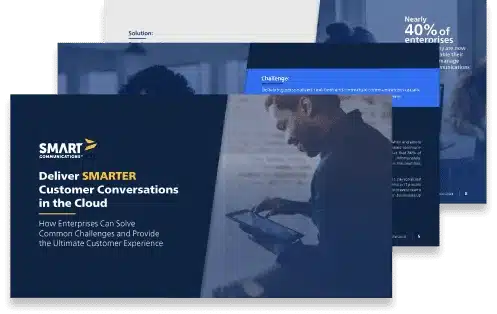How Health Insurance Document Automation Transforms Policyholder Communications

By John Zimmerer, VP of Healthcare Marketing at Smart Communications
In the rapidly evolving landscape of health insurance, the need for efficient, compliant, and personalized policyholder communications has never been more critical. Health IT professionals are tasked with navigating complex regulatory environments, ensuring data security, and delivering high-quality communications to members. Yet some companies still rely on manual processes, legacy systems, or ad-hoc communication tools that can hinder efficiency and consistency.
Health insurance document automation platforms and customer communication management (CCM) systems play a pivotal role in achieving these goals. This blog post:
- Details the key steps of the document production process
- Outlines some of the regulations and compliance considerations across the United States, United Kingdom, Germany, and Australia
- Highlights the benefits of adopting a modern, cloud-based CCM solution
Automating the Document Production Process for Policyholder Communications
Health insurance IT and lines of business are responsible for a myriad of member-facing communications. These include benefit booklets, policy documents, statements, and other critical communications that must be accurate, timely, and compliant with regulatory standards. Document automation platforms and CCM systems are essential tools in this process, enabling health insurers to streamline operations, reduce errors, and enhance member engagement.
The document production process for member-facing communications involves several key steps:
1. Content Creation: Drafting the initial content, often using templates to ensure consistency.
2. Review and Approval: Multiple stakeholders review the documents to ensure accuracy and compliance.
3. Formatting and Design: Applying branding and formatting to make the documents visually appealing and easy to read.
4. Distribution: Delivering the documents to members through various channels, such as mail, email, or online portals.
CCM solutions play a crucial role in this process by automating repetitive tasks, reducing errors, and ensuring consistency across all communications. These platforms offer features like template management, workflow automation, and integration with other systems to streamline the document production process and transform policyholder communications.
Health Insurance Document Automation Regulations and Compliance
Compliance with regulations is critical in the healthcare industry. Member-facing documents must adhere to standards set by regulatory bodies like the Centers for Medicare & Medicaid Services (CMS) and the National Committee for Quality Assurance (NCQA) in the United States. These regulations ensure that communications are clear, accurate, and timely. For example, the Medicare Communications and Marketing Guidelines (MCMG) outline specific requirements for the content and distribution of member communications.
Beyond the United States, regulatory frameworks in the United Kingdom, Germany, and Australia also play a significant role in shaping policyholder communications.
A Modern CCM Solution for Health Insurance Communications
A leading cloud-based CCM platform can be transformative for health insurers seeking to scale personalized, interactive communications across digital and traditional channels. These solutions enable organizations to meet rising expectations around engagement, compliance, and operational efficiency. Below are several core features and benefits of an advanced CCM platform built for the complexities of health insurance communications. Key capabilities should include:
1. Omnichannel Communications
A modern communication platform empowers insurers to engage policyholders via their preferred channels—email, SMS, print, and digital portals—ensuring a seamless and consistent experience across touchpoints.
2. Template Management
Using a single-template model, top-tier CCM systems simplify the development and maintenance of documents. This agility allows insurers to respond quickly to regulatory updates, product changes, or the need to onboard new distribution channels.
3. Approval Workflows
Integrated approval workflows ensure all content undergoes the necessary compliance checks before it reaches policyholders, minimizing risk and streamlining collaboration across departments.
4. Audit Trails
Comprehensive audit capabilities create a traceable history of all edits, approvals, and publication steps. This transparency is critical for passing regulatory audits and maintaining governance.
5. System Integration
A robust document automation solution integrates easily with ecosystem partners such as HealthEdge, Pegasystems, and Salesforce. These integrations reduce IT dependencies and ensure data flows freely across systems to support dynamic, personalized communications.
Business Benefits
1. Efficiency Gains:
By consolidating disparate communication processes into a unified cloud CCM solution, organizations can reduce template maintenance by up to 95%, leading to faster turnaround times and fewer errors.
2. Cost Reduction:
Health insurers using cloud-native CCM tools frequently report measurable cost savings—ranging from shorter implementation cycles to the redeployment of full-time staff toward strategic initiatives.
3. Enhanced Member Experience:
Interactive, targeted messaging contributes to better policyholder experiences. A personalized approach drives stronger engagement, trust, and satisfaction—critical differentiators in today’s competitive healthcare environment.
4. Regulatory Compliance at Scale:
With built-in controls and centralized management of content, regulatory updates can be applied across a communications portfolio with minimal effort. This proactive approach reduces compliance risks while keeping messaging accurate and up to date.
5 Reasons to Use SmartCOMM for Document Automation
Health IT professionals familiar with document automation should consider adopting SmartCOMM for several compelling reasons:
1.-Regulatory Compliance
SmartCOMM's robust compliance features ensure that all member communications adhere to regulatory standards across multiple jurisdictions. The platform's built-in approval workflows, audit trails, and template management capabilities help organizations stay compliant with regulations like HIPAA, GDPR, and other regulations in the United States, United Kingdom, Germany, and Australia.
2.-Efficiency and Cost Savings
By automating the document production process, SmartCOMM significantly reduces the time and effort required to create, review, and distribute member communications. This leads to substantial cost savings and allows health IT professionals to focus on more strategic initiatives. The platform's integration capabilities further enhance efficiency by streamlining workflows and reducing IT reliance.
3.-Enhanced Member Experience
Personalized and interactive communications are key to improving member engagement and satisfaction. SmartCOMM's omnichannel capabilities ensure that members receive consistent and relevant communications through their preferred channels, making interactions more meaningful and effective.
4.-Scalability and Adaptability
SmartCOMM's cloud-based architecture allows organizations to scale their communication efforts effortlessly. The platform's single-template approach and real-time updates enable health insurers to quickly adapt to regulatory changes, new product launches, and emerging communication channels.
5.-Integration with Existing Systems
SmartCOMM integrates seamlessly with other core systems, enhancing operational efficiency and reducing the need for extensive IT resources. This integration capability ensures that health IT professionals can leverage existing investments while optimizing their communication processes.
Conclusion
In the complex and highly regulated world of health insurance communications, the need for efficient, compliant, and personalized member interactions is paramount. Document automation platforms and CCM systems like SmartCOMM offer powerful solutions to meet these challenges to help transform policyholder communications.
By leveraging sophisticated cloud solutions, health insurers can ensure regulatory compliance, improve operational efficiency, enhance member experience, and adapt to changing communication needs.
Ready to learn more about optimizing policyholder communications?
Request a demo to see our document automation capabilities in action.
About the Author
John Zimmerer is the Vice President of Vertical Marketing, Healthcare at Smart Communications, where he acts as a subject matter expert on the digital transformation of customer communications and data-centric, often form-based workflows. Most recently, John has been researching and writing about improving customer experience in healthcare and is regarded as a thought leader in this area. John has over 20 years of software product marketing experience. His areas of expertise include market research, analyst relations, public relations, and digital marketing.



